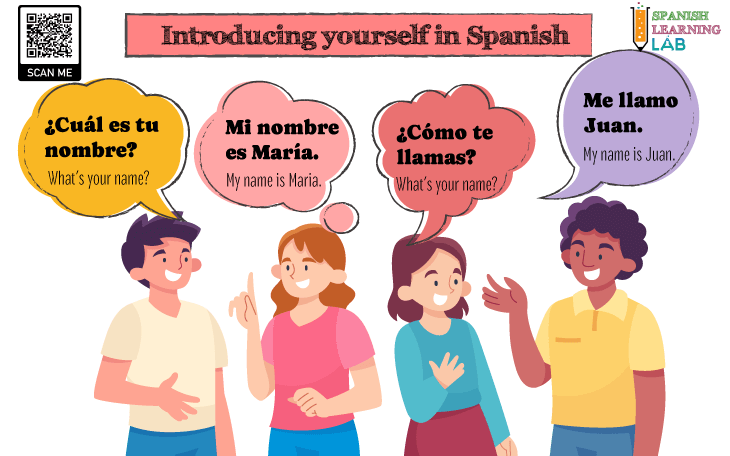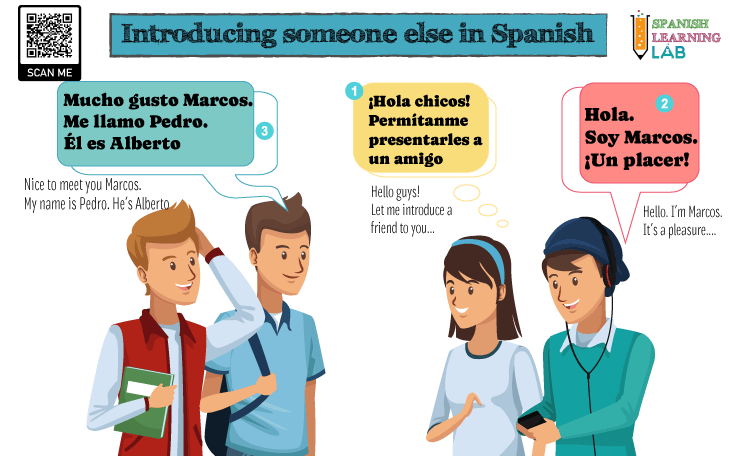Knowing how to introduce yourself in Spanish is always the first step to begin a good, simple conversation, especially with someone you just met. The expressions and questions for introductions (presentaciones) are very similar to the ones in English. They are usually accompanied by one or more greetings, e.g. “Hola”. This lesson will cover some common ways to introduce yourself in the language, as well as expressions to introduce others. You will read and listen to several examples and practice with an interactive quiz. Once you finish, you can move on to the lesson about greetings.
The basics for Spanish Introductions – Las presentaciones
First, we will ask you to watch a short video explaining a few basic ways to introduce yourself in Spanish, plus some expressions that are really common in order to introduce someone else too. Please watch the video carefully, as it will be useful to understand and get the best out of this lesson. Please activate the subtitles if you need them. Once you have finished, solve the exercises in the interactive quiz.
How to introduce yourself in Spanish
Before introducing yourself in Spanish, you should use simple greeting like HOLA and then add an expression like MUCHO GUSTO or ask the other person politely ¿Cómo estás?. Here are two examples:
1. ¡Hola! ¡Mucho gusto conocerte!
2. ¡Hola! ¿Cómo estás?
Question words like CÓMO (How) and CUÁL (Which) are essential to ask for names, just like in these two very common examples: ¿Cómo te llamas? and ¿Cuál es tu nombre?. In general, the subject pronoun TÚ is more informal than USTED, but it is also more common. Omitting the subject pronoun in a sentence is normal, but make sure you are using the right conjugation of the verb for the subject even if you leave it out. Here is a list of ways to introduce yourself in Spanish and get another person’s name:
| Introduce yourself in Spanish – Las presentaciones |
|---|
|
¡Hola! Mi nombre es Alex (literal translation)
Hello! My name is Alex
|
|
¡Hola! (Yo) Me llamo Jon(I am called Jon. LLAMO is a conjugation of the verb LLAMAR)
Hello! My name is Jon
|
|
¡Hola! (Yo) soy Jon. (SOY is a conjugation of the verb SER, to be)
Hello! I am Jon
|
| ¿Cuál es tu nombre? (TU is a possessive adjective for something that belongs to EL or ELLA) What’s your name? |
|
¿Cuál es su nombre? (SU is a possesive adjective for something that belongs to USTED)
What’s your name?
|
| ¿Cómo te llamas (tú)? What’s your name? |
| ¿Cómo se llama (usted)? What’s your name? |
|
¿y tú? (a simple way to return a question)
And you?
|

Let’s briefly analyze the structure of the Spanish introductions that we have covered so far. First, the word “tu” in TU NOMBRE and “su” in SU NOMBRE are possessive adjectives. Notice that the verb LLAMAR (to call) changes its form depending on the pronoun we use. Grammar is important but for now, we will ask you to focus on their meaning and pronunciation as we will develop more on grammar in future lessons.
How to introduce someone in Spanish
In order to introduce someone in Spanish, we will need the verb SER in its forms ES and SON. Basically, if we are referring to one person, we will use “ES” as in “ÉL ES…” (he is) and “ERES“ for “TÚ“ as in “TÚ ERES…”, but if we are referring to several then we must use “SON” as in “ELLOS SON…” (they are). Besides, when you introduce someone else in Spanish, it is important to mention if this person is your friend, relative or something else using possessive adjectives, e.g. “Él es mi amigo” (he is my friend).

Please mind the pronoun you choose so that you use a pronoun that corresponds properly in gender and number to the person you are introducing. Here are some more examples of Spanish introductions that you can read and listen to. Focus on pronunciation and try to find out grammatical patterns.
| Introduce someone in Spanish – Presentando a otros |
|---|
|
Su nombre es Ana (Introducing a woman – SU is a possessive adjective meaning HER)
Her name is Ana
|
|
Ella es Mary (ES comes from the verb SER, to be)
She is Mary
|
|
¿Cuál es su nombre? (“su” = his)
What’s her name?
|
|
¿Cuáles son sus nombres? (“sus” = their)
What are their names?
|
|
¿Cómo se llama (ella)? (“se” is the reflexive pronoun for “ella”)
What’s her name?
|
|
¿Cómo se llaman (ellos)? (“se” is the reflexive pronoun for “ellos”)
What are their names?
|
|
Permíteme presentarte a mi amigo.
Let me introduce my friend to you
|
|
Les presento a la nueva maestra
I introduce the new teacher to you
|
Listening Activity: Ways to introduce yourself and others in Spanish
Spanish introductions and greetings PDF Worksheets
- Greetings and farewells in Spanish – PDF Worksheet (Vocabulary)
- Getting to Know People in Spanish: PDF Worksheet (Speaking)
- Talking about Yourself in Spanish: PDF Worksheet (Speaking)
- Meeting People in Spanish – PDF Worksheet (Reading)
- Dialogues – Introductions and greetings in Spanish
- Practicing Spanish Introductions – PDF Worksheet

Hi, am I right if I think “Les presento a la nueva maestra” should be translated as ” I introduce the new teachers to you”. I mean, “Les” refers to plural nouns, so it would be “teachers” not “teacher”?
Great question! The translation we provided is fine as “I introduce the new teacher to you (the students)”. The reason is that “LES” refers to the students, not the teacher in this sentence. If we want to introduce the new teacher to the principal of the school, then we would say “LE presento a la nueva maestra” (a usted). Similarly, if we were to introduce the teacher to a friend, then we could say “TE presento a la nueva maestra” (a ti). Hope it helps a little!
Ya!
¿Cómo te llamas?
Hola! Me llama Mariah. ¿Y tu?
Just so you know, I came up with a fake name, because I don’t want people to know my personal info… That is not my real name! 🙂
¿Como estas?
My mother grew up in Mexico city and is teaching me, so I already knew a couple of those things, but I didn’t know some of the greetings. I really liked it! Thank you!
We’re glad you liked this article. Best of luck learning Spanish. ¡Hasta pronto! 🙂
¡Hasta pronto!:)
I love speaking Spanish! Thank you!
This fun yes:)
My name is Andrew and I am just learning spanish
¡Buena suerte aprendiendo español! Saludos
Why can’t question 5 be answered “mi hombre es Diana”?
Hola. Well, the question is “¿Cuál es el nombre de tu mamá?” (What is her mother’s name?) so we are asking about “HER”. HER/HIS are translated as “Su” into Spanish. Her name is Marta – Su nombre es Marta.